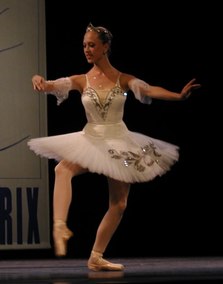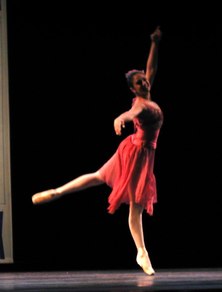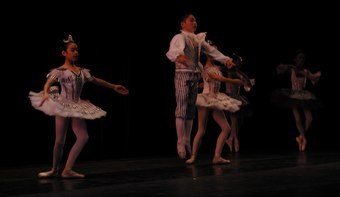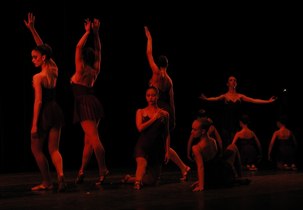|
|
 |
 |
The finals of the Youth America Grand Prix 2001 were held in New York City from May 4 to May 6. Regional competitions in classical and contemporary ballet were held in Denver, CO, Long Beach, CA, Chicago, IL, Boca Raton, FL, Winston Salem, NC, Torrington, CT, and Philadelphia, PA. As a result, the competitors in New York represented some of the best young ballet dancers in the United States - plus a few outstanding dancers from Japan and Europe. The dancing was consistently inspiring. The dancers rose to the occaison such that I kept thinking, "How did she do that?" To be sure, a few dancers didn't stick their landing at the end of their routines, and a dancer stumbled during her routine once in a rarely. A youth dance competition is mostly about potential, so perfection isn't required for the audience to cheer the dancers on. You should keep in mind that I am not a Ballet aficionado (I am mostly a Ballroom/American Smooth dancer), so I could be pardoned, as good as the dancers were, if I had started to say to myself, "Not another Esmeralda Variation?!" Quite the contrary. The beauty of the Youth America Grand Prix was that at the same time it gave the participants the chance to push their craft to new heights (literaly when en pointe) and go home with feedback from a group of top judges, the event as a whole gave me a chance to gain insight into a foreign dance world. By "foreign" I am NOT referring to the numerous number of superb dancers wandering around chatting away in Russian. We have plenty of superb Russian dancers in Ballroom too. I am not particularly familiar with Ballet's established body of choreography. The Youth America Grand Prix 2001 gave me the opportunity to see a solid range of choreography - much of it by Petipa, but more on that later. A body of named choreography is one of Ballet's strength's. The lack thereof, in my opinion, is one of Ballroom's current weaknesses. Ballroom is still stuck in a Guild stage of its intellectual property evolution - people tend to treat choreography as trade secrets. One way to appreciate the nuance of choreography is to see the same work performed over and over again. For instance, in the three sessions from 3 PM to 7 PM on Saturday, Esmeralda's Variation (choreography by Vaganova) was performed five times. At first, I was impressed that the dancer could play the tambourine while dancing en pointe. After the third rendition, it started to look like a gimmick - an impressive gimmick to be sure. The tambourine seemed decoration. If dance is the movement of the body transformed into art, a prop takes away from the dancer's purity of expression. But then, in the fifth and final rendition of this block of sessions, Andrea Emmons (18 years old, teacher Teresa Emmons) performed Esmeralda's Variation. She played the tambourine with authority, as a musical instrument and not just as a decoration. By seeing the choreography interpreted five times in short succession, it was possible to see that Vaganova was communicating that it is possible for there to be a unity between dance and music. Seeing this sequence of Esmeraldas, it was possible to see the same message in the special guest performance of Mucuy Bolles' choreography entitled "Antigamente" (translated as "once upon a time…") where Ms. Bolles seamlessly interacted with her moving (both literally and musically) violin accompianist, Daniel Roumain. The Esmeralda Variation is an example of classical ballet while Mucuy Bolles' work is an example of contemporary ballet, but the choreographic idea is the same. In addition to gracing the stage as a guest performer Sunday night, Mucuy Bolles was one of the competition's panel of judges. The other judges were Robert Berthier, Oleg Briansky, Giuseppe Canale, Eleanor D'Antuono, Ana Marie Forsythe, Martin Fredmann, Melissa Hayden, Katrina Killian, Kevin McKenzie, John Meehan, David Richardson, Suki Schorer, Gailene Stock, Nadia Tencer and Laura Young. A distinguished group if there ever was one. The following sections of this report include an interview with a judge, an interview with a Grand Prix finalist, a somewhat tongue-in-cheek proposal to take Ballet to new heights, and pictures galore. Even if you read no further than this, I strongly suggest that you consider attending or participating in the next Youth America Grand Prix. If you are a young dancer, you will have an opportunity to work on your craft. If you are a Balletomane, you will see much great dancing at a price well below what you would pay for a single night at the theatre. If you know nothing about Ballet, you will walk away richer for the experience. You can find the Youth America Grand Prix web site at www.youthgrandprix.com .
I had an opportunity to interview Mr. Canale about his role as judge and his views on dance. Mr. Canale was born in Italy and received his dance training at the National Academy of Dance in Rome, Maurice Bejart's Mudra dance school in Switzerland, and the School of American Ballet. He has toured extensively as a dancer with such companies as Maurice Bejart's Ballet of the 20th Century (Bruxelles), Ballet Company of Jean Deroc (Switzerland), Ballet Company of Germinal Casado (West Germany) and the Het National Ballet (Netherlands). Mr. Canale has choreographed works for Het National Ballet and for Teatro Massimo, becoming its Artistic Director in Italy in 1994. As the director of the company, he revitalized the theatre's repertoire and initiated multiple arts outreach programs. Since moving to the United States, Mr. Canale has become the Co-Director of The Northeast Academy of Dance and has appeared as a judge at the Luxembourg International Ballet Competition. Robert Abrams: What do you look for when you judge a ballet competition? Giuseppe Canale: Respect. Dance that is appropriate for the age of the dancer. Clean technique. Physical possibilities. Musicality. Coordination. I try to encourage them, to encourage their talent to go further. RA: What has impressed you the most about the dancers here? GC: There is a lot of talent here. A lot of good, young girls who are nine, ten, or eleven years old. They are very strong. RA: Are there differences between young ballet dancers in the US, compared to in Europe or other parts of the world? GC: Americans are different than Europeans. I love Americans for their attack. RA: Could you expand on what you mean by "attack"? GC: They go for it. They don't hesitate. They have energy floating. That's nice. RA: Why do so many young ballet dancers choose to dance to choreography by Petipa? GC: Petipa is one of the classical Russian choreographers. He was the greatest classical ballet choreographer. Everything comes after him. RA: How can young dancers give back to their community? GC: Do competitions. It is not just about winning. The experience of being with other students. Share the experience of being with other kids, other students. Reach by seeing other students. RA: What makes you passionate about dance? GC: I love dancing. Dance has been my life. I have been dancing since I was a child. I love to see beautiful dancers.
As brilliant as the Vitae of the judges may be, a ballet competition is first and foremost about the young dancers. I had a chance to talk to Emily Zimms, one of the participants, about her dance experience. Ms. Zimms is fifteen years old. She studies with Inessa Pakri at the Academy of Colorado Ballet. She was the winner of the Denver Regionals, and placed in the final twelve of the Senior Grand Prix category at the New York Finals. Robert Abrams: How did you start in dance? Emily Zimms: My cousin. I wanted to be like her. I was inspired. I took Jazz first. I took Ballet when I was ten. I have been dancing Ballet for five years. RA: What has been best about this experience? EZ: Coming to New York. Being with great people. It has been a great experience. Getting help with my teacher to prepare for the competition. Things that seemed big in the past don't seem as big now. The competition is also good to have in my resume. RA: Why are you passionate about dance? EZ: Expressing yourself, it is fun for others. However, I don't even see them (the audience) - performing is for me. What I love the most is that it makes me the happiest. RA: What are your goals for your dancing? EZ: I have to do the next production at CB2. Le Sophide, a solo part. We will have two performances. We still need to go over it and get it together in rehearsal. 

There is a part of Ballroom that wants to be like Ballet, with an emphasis on technique, clean lines and performance. There is another part of Ballroom that wants to be like Basketball and other sports. It is with this experience of dance-as-sport in mind that I offer the following suggestion for taking Ballet competitions to the next level - only partly tongue in cheek. Several participants danced choreography in which they used a bow as a prop and pantomimed firing arrows at some unnamed target - perhaps a deer, perhaps a lover. To be most convincing, a dancer must convince the audience that she really is firing an arrow. To so convince the audience, the dancer is likely to benefit from some practice firing actual arrows. Moreover, dance can be about motion and stillness. To demonstrate both elegant motion and stillness in the same performance is surely evidence of mastery. One existing sport in which participants must demonstrate both motion and stillness in the same event is the Biathlon: participants must cross-country ski and then fire a rifle at a target, ski again, stop and fire at a target, and so on until the finish line. The competitor's score is a combination of his time from start to finish and the accuracy of his shots at the targets. Imagine, then, a stage set with perhaps five large targets. The dancer must dance for a minimum number of seconds, stop, fire an arrow at the first target, dance again, fire an arrow, and so on until all five targets are attempted. To succeed, a dancer would have to go from motion (dancing), to stillness (archery) repeatedly. The scoring would be a combination of the current system of judging artistic merit, combined with the accuracy of her arrows. There might also need to be a few additional rules, such as "A dancer will be disqualified if she skewers a stagehand with her arrrow." Sure, it sounds like a gimmick, but playing the tambourine en pointe can look like a gimmick too until you see it done well. Are you up to the challenge?
There was one aspect of the event that frankly made no sense. This was not the revelation that there is such a thing as a tutu bag. There were a small handful of dancers who were competing as individuals, but who danced with a non-competing partner. While I appreciated the partner's dancing as art, I do not see what it added to the judges' ability to evaluate the competing dancer's ability. If partnering skills are part of the evaluative criteria, then all dancers in the competition should be judged on this basis. If partnering skills are not part of the evaluative criteria, no dancers should compete with a non-competing partner and should reserve such skills for the ensemble category. From a Ballroom perspective, moreover, this anomaly goes deeper. The few dancers who did compete with a partner used choreography that didn't involve much actual partnering. Much of the time when both partners were on stage simultaneously, one partner would dance alone while the other stood still, and then they would reverse roles. When the two dancers were dancing in partnership, it was mostly limited to the man spinning the woman en pointe, plus a lift here or there. As I said before, I know a minimal amount about Ballet, so I do not want to let any subcutaneous strictly ballroom attitude let me jump to conclusions (the better one gets in dance, the more one has to guard against "attitude" and the creeping rigidity it brings), but I think that, based upon my own experience in Ballroom as well as evidence which could be seen in the Youth America Grand Prix ensemble performances, young ballet dancers can do a great deal more with partnership dance within the structure of Ballet than was evidenced in the few individual performances that incorporated a non-competing partner. If the Youth America Grand Prix were to add a partnership or duet category to the competition, I am sure that students, teachers and choreographers would rise to the challenge.
Enough talk, serious or otherwise. Here's what you are probably really interested in: pictures. The pictures were taken with an Olympus C-3030 digital camera. An F stop of 2.8 and a shutter speed of 1/125th of a second was used as a compromise between stopping the action and having sufficient exposure. While there is no substitute for seeing dance performed live, especially since the human eye is a much more sophisticated light gathering device than any camera yet invented, the camera can reveal a beauty of the dance that is often too fleeting to see in the moment. With this in mind, the participants of the Youth America Grand Prix may represent the future of Ballet, but the beauty of their dance is now.
Pictures of performances are generally in the format:
Clicking on a picture will show you a larger version of the picture.
Mallory Clark, 16
Aurora Variation, Sleeping Beauty
Amy Price, Amanda Shepard
Petipa

Arolyn Williams, 15
Paquita Variation
Jeremy Collins
Petipa

Marlena Bono, 17
Esmeralda Variation
Valia Seiskaya
Vaganova

Rachael Meyer, 15
Aurora Variation, Sleeping Beauty
Judy James, Annette Debas, Juan Sanchez
Petipa


Nicole Torgerud, 17
Variation from Le Corsare
Jo Jean Retrum
Sergeyev

Jacqueline Rafferty, 18
Giselle Variation
Wes Chapman, Roger Van Fleteren
Perot

Saran Vaaler, 19
Venice Carnival
John and Margrita Withes
Petipa

Taryn Olivieri, 15
Swan Lake, Pas de Trois
Charles Maple
Petipa



Cynthia Heidelberg, 17
Black Swan Variation, Swan Lake
Bonnie Mathis, Lirena Branitski
Petipa, Ivanov

Kotoe Kajima, 17
Kitri's Variation
Valentina Kozlova
Petipa



Suzanne Takahashi, 16
Le Corsaire Variation
Ayako Takahashi
Petipa

Daphne Zneimer, 18
La Bayadere
Marat Daukayev
Petipa


Hannah Kugler, 16
Sugar Plum Fairy
Alan Woodard
Lev Dvanov


Megan Huter, 15
Giselle Variation
Inessa Pakri
Perrot

Lauren Menger, 17
La Bayadere
Valia Seiskaya
Petipa



Amy Ruggiero, 17
Variation from Etudes
Valia Seiskaya
Lander



Fitzgerald (#800)
???
???
???


Madge Turner, 18
Variation, Esmeralda
Magdalena Maury
Vaganova


Ashley Kohl, 17
Black Swan
Sharon Story
Petipa


Michelle Thompson, 17
Sugar Plum Variation, Nutcracker
Inna Bayer
Inna Bayer

Katherine Whitlock, 15
Paquita Variation
Magdalena Maury
Petipa



Tara Kaleta, 15
Paquita Variation
Mary Moe Adams
Petipa

Rachel Lieberman, 15
Les Selphides
Nadia Veselova-Tencer
Fokine


Jarvi Raudsepp, 15
Variation from La Fille Mal Gardee
Nadia Veselova-Tencer
???



Miriam Golumb, 15
Paquita Variation
Olga Kresin
Petipa



Heather O'Halloran, 16
Paquita Variation
Mihailo Djuric
Petipa

Mary Ellen Beaudreau, 15
Paquita Variation
Mihailo Djuric
Petipa

Brigid O'Grady, 16
Pas De Trois' Variation, Swan Lake
Inessa Parki
Petipa



Hillary Lopes, 15
Kitri Variation, Don Quixote
Mishailo Djuruc
Petipa


Emiko Mannehs, 16
Aurora Variation, Sleeping Beauty
Kumiko Fujii
Petipa




Tatyana Martyanova, 17
Paquita Variation
Svetlana Osiyeva
Petipa


Kate Brezovsky, 17
Variation from Le Corsaire
Svetlana Osiyeva
Petipa



Elizabeth Chasteler, 17
Satanella Variation
Salwa Rizkalla
Petipa




Mira Allmeyer, 15
Kitri Variation, Don Quixote
Inessa Pakri
Petipa




Stephanie Bauger, 17
Medora Variation, Le Corsaire
Armando Gonzalez
Petipa

Priscilla Marrero, 15
Sleeping Beauty Variation
Liana Navarro
Petipa




Gabrielle Zucker, 18
Sylvia Variation
Eleanor D'Antuono, Susan Goldman
Balancine


Sara Mearns
Variation from Grand Pas Classique
Shamil Yagudin
Gsovsky



Melissa Thomas, 17
Variation from Satanella
Wes Chapman, Roger Van Fleteren
Petipa



Regina Palomar, 16
Variation from Diana & Acteon
Lucy Arce
Vaganova



Yuki Yasuda, 15
Giselle Variation, Act 1
Asako Ito
Perrot, Coralli



Cynthia DeGuzman, 16
Variation from Pas de Classique
Liana Navarro
Gsovsky



Amber Jackson, 16
Black Swan Variation
Jo Jean Retrum
Petipa, Ivanov





Victoria Lane Green, 17
Paquita Variation
David Moroni, Galina Yordanova, Jacqline Weber
Petipa


Andrea Emmons, 18
Esmeralda Variation
Teresa Emmons
after Vaganova


Emily Lynn Zimms
Queen of Driad Variation, Don Quixote
Inessa Pakri
Petipa

Melissa Hough, 16
Gamzatti Variation
Vladmir Djouloukhadze, Alla Sizova, Michele Wiles
Petipa

-
Likolani Brown, 16
Grand Pas Classique
Patricia Berrend
Gsovsky





Kyra Homeres, 16
TBA
Christine Spizzo
Petipa

Elizabeth Gahl, 15
Diana and Actaeon
Patricia Berrend
Vaganova





Elizabeth McGrath, 18
Variation from Satanella
Svetlana Osiyeva
Petipa



Jennifer Whalen, 18
Don Quixote
Linda Strangio-Hedberg
Petipa







Simone Elena Messmer, 16
Gamzatti Variation
Bonnie Mathis
Petipa

Courtney Clarkson, 15
Corsaire Pas De Deux
Magda Aunon, Magali Suarez
Petipa






Ashley Laracey, 17
Nutcracker Variation
Svetlana Osiyeva, Oliver Pardina
???





The audience packed the theatre.

Alexander Dutko, 14
Don Quixote Variation
Sarah Reid, Jessica Haris
Petipa, Gorski

Bo Busby, 17
Nutcracker Variation
Svetlana Osiyeva, Oliver Pardina
Oliver Pardina


Kiyoshi Kawano, 12
Le Corsaire
Ayako Takahashi
Petipa

Anthony Spaulding, 15
Golden Idol from La Bayadere
Kee-Juan Han
Petipa


Mathias Heymann, 13
Variation Espagnole
Veronique Sottile
Durand

Christopher Espinoza, 16
Le Corsaire
Liana Navarro
Petipa

Cory Stearns, 15
Black Swan
Valia Seiskaya
Petipa


Colby Damon, 16
Bluebird Variation, Sleeping Beauty
Petrus Bosman, David Keener
Petipa

Stephen King, 14
Pas De Trois Variation, Paquita
Dmitry Malikov, Slava Mesropov
Petipa

Brooklyn Mack, 13
Corsaire Variation
NA
Petipa



Benjamin Harber, 19
Variation, Don Quixote
Stela Viorica, Marat Daukayev
Petipa








James Whiteside, 16
Angela D'Valda Sirico, Steve Sirico, Franco DeVita
Petipa




Sarah Bodley, 18
La Fille Mal Gardee
Donna Bonasera, Bryan Lewis
Gorsky


Britany Larsen, 16
Gulnare Variation, Le Corsaire
Debra Collins Ryder
Petipa


Stephanie Wisner, 15
Adele Variation, Die Fledermans
Sherry Moray
Ruth Page



Shannon Jones, 16
Variation, Coppelia
Teresa Emmons
After Saint Leon




Robin Benowitz, 18
Le Corsaire Variation
Sherry Moray
Petipa




Maria Tayag, 16
Kitri Variation, Don Quixote
Malu Rivera-Peoples, Inna Bayer
Petipa


Jennifer Yackel, 16
Giselle Variation, Act 1
Teresa Emmons
Perrot, Coralli




Maan Nabong, 15
Paquita Variation
Sherry Moray
Petipa



Katie Canavan, 16
Odette Variation, Swan Lake Act 2
L. Gulyeva
Petipa



Jordan Gazdziak, 15
Raymonda, Act 2 Allegretto Variation
Sherry Moray
Ruth Page




Rosie Lathrop, 16
Rosalinda Variation, Die Fledermaus
Sherry Moray
Ruth Page




Allison Campbell, 15
Aurora Variation
Cassandra Crowley
L. Alonzo after Petipa

Liliane Guillot, 17
Raymonda Variation, Act 1
Marina Noodga
Petipa


Michelle Beyerle, 18
Esmeralda's Variation
J. Anibal Macedo
Petipa



Rehearsal for the Grand Finale







Saturday Night Award Winners


SUNDAY - The finals, Ensemble competition finals, special guest performers, the grand finale, the award ceremony.













































































































































































































|
|